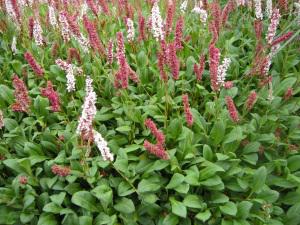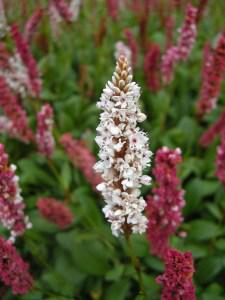
Polygonum affine (28/07/2011, London)
Position: Full sun to partial shade
Soil: Well drained
Flowering period: Late summer to autumn
Eventual Height: 30cm
Eventual Spread: 30cm
Hardiness: USDA Zone 3a-9b
Family: Polygonaceae
Persicaria affinis is an evergreen perennial with a mat-forming habit. Its foliage is narrowly elliptic and dark green in colour, turning bronze in winter. In late summer to autumn it bears dense spikes of small, funnel shaped, rose red flowers.
P. affinis, commonly known as Himalayan Knotweed and in some botanical circles as Polygonum affine, is native to parts of Asia including china and the Himalayas.
Persicaria was a medieval name referring to the likeness of the leaves to a peach tree, Prunus persica, with affinis being derived from the Latin for ‘related to’.

Polygonum affine flower (28/07/2001, London)
This plant may be useful to the landscape architect en mass as an effective low growing ground cover .It is suitable for planting on slopes or banks where low maintenance is required.
The Royal Horticultural Society gave the cultivars Persicaria affinis ‘Darjeeling Red’, ‘Donald Lowndes’ and ‘Superba’ their prestigious Award of Garden Merit in 1993.
This plant will tolerate almost any soil conditions; it will be happy at acid, neutral or alkaline pH levels, in loam, clay, chalk or sand based soils, preferring a west, east or south facing exposed or sheltered aspect.
Ecologically this plant will attract many species of pollinating insects such as honey bees and butterflies.
Maintenance: This plant requires little to no maintenance. The flowers may dead headed to prolong the flowering period. Large clumps may be propagated by division in spring or autumn.

